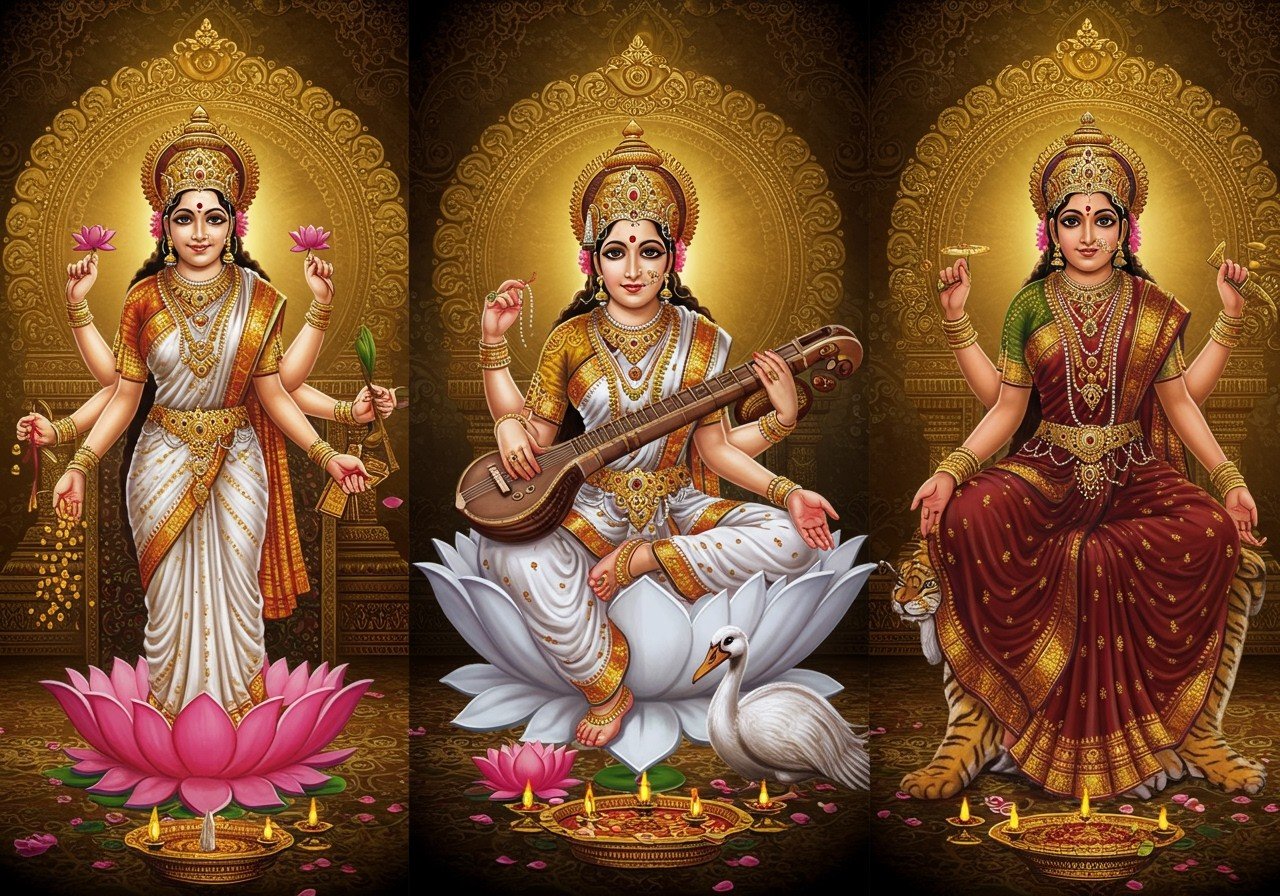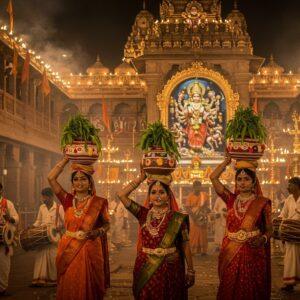
The concept of a Goddess Trinity, or Tridevi, is a cornerstone of Hindu belief. This trinity, composed of Lakshmi, Saraswati, and Parvati, embodies the divine feminine principle, with each deity possessing unique attributes. This article delves into the diverse expressions of Tridevi worship across India, highlighting regional variations and cultural nuances.
Tridevi in Northern India
Northern India, especially the Hindi-speaking belt, reveres the Tridevi with distinctive customs. Navratri, a major festival celebrating the divine feminine, is observed with great enthusiasm in states like Uttar Pradesh and Punjab, marked by vibrant rituals and devotional prayers. Saraswati, the goddess of knowledge and wisdom, receives special homage during Vasant Panchami, a day dedicated to learning and the arts. Educational institutions often hold special ceremonies on this day.
Lakshmi, the goddess of prosperity, is deeply associated with Diwali. Families perform rituals to invite abundance and good fortune into their homes. In the Himalayan regions, Parvati, as the consort of Shiva, holds immense significance within Shaivism. Hindi literature and hymns enrich these devotional practices, adding layers of cultural meaning.
Understanding the Hindu Calendar: Festivals and Auspicious Dates
Tridevi in Southern India
Southern India’s approach to Tridevi worship presents unique traditions, particularly in Tamil Nadu. Saraswati Puja during Navratri is a key event, emphasizing the importance of education and artistic pursuits. Lakshmi is venerated during Varalakshmi Vratam, a specifically Tamil observance symbolizing wealth and well-being. The festival often involves elaborate rituals and offerings.
Parvati, often linked with Goddess Meenakshi of Madurai, plays a central role in temple festivals. The rich tapestry of Tamil literature, including the works of poet-saints like Andal, reflects the deep devotion to the Tridevi. Tamil Nadu’s magnificent temples stand as testaments to the goddesses’ enduring presence.
Tridevi in Western India
Western India, encompassing states like Maharashtra and Gujarat, offers distinct practices in Tridevi worship. Gauri Puja in Maharashtra centers on Parvati, often involving family gatherings and traditional rituals. In Gujarat, Lakshmi is central to Diwali festivities, highlighting her connection to prosperity and commerce. Celebrations are marked by vibrant decorations and the exchange of gifts.
Saraswati’s presence is prominent in Maharashtra’s cultural landscape, underscoring her significance in music and the arts. The region’s rich literary and folk traditions, expressed in Marathi and Gujarati, contribute significantly to the reverence for the Tridevi. Traditional art forms like Garba and Dandiya often incorporate elements of goddess worship.
Tridevi in Eastern India
Eastern India, especially Bengal and Odisha, embraces the Tridevi with unique fervor. Durga Puja, a grand celebration of Parvati in her form as Durga, is the centerpiece of the region’s festive calendar. Elaborate idols of Durga are worshipped with intense devotion, accompanied by music, dance, and cultural performances. This festival embodies cultural unity and spiritual dedication.
Lakshmi Puja follows Durga Puja, inviting prosperity and abundance into homes through specific rituals, including the creation of intricate rice flour patterns called Alpana. Saraswati Puja, celebrated during Vasant Panchami, is particularly significant in educational settings. The rich traditions of Bengali literature and music weave through these celebrations, with hymns and devotional songs dedicated to the goddesses. The region’s artistic heritage, reflected in its sculptures and paintings, beautifully captures the divine essence of the Tridevi. Durga Puja in Kolkata: A Celebration of Culture and Tradition
Pure Brass Maa Tara Murti
Pure Brass Maa Tara Murti
Pure Brass Maa Tara Murti
Pure Brass Maa Tara Murti
Tridevi in Central India
Central India, with its diverse cultural landscape, presents yet another perspective on Tridevi worship. States like Madhya Pradesh and Chhattisgarh observe Navratri with unique regional rituals, often blending mainstream Hindu practices with local tribal customs. This creates a rich tapestry of beliefs and traditions.
The influence of tribal traditions is particularly evident in the merging of local deities with the Tridevi in folk narratives. Storytelling, songs, and dances often portray the goddesses as protectors and nurturers, deeply embedded in the community’s way of life. These local myths add depth to the understanding of the Tridevi, extending their significance beyond formal worship. Regional languages and dialects further enrich these traditions. Chhattisgarh Temples: Architectural Wonders and Spiritual Significance
Cultural Synthesis and Modern Interpretations
In an increasingly interconnected world, Tridevi worship is also evolving. Globalization, facilitated by the internet and social media, exposes regional variations to a wider audience. Online platforms now offer easy access to traditional ritual items, enabling devotees worldwide to honor these goddesses. In urban centers, diverse communities often blend their practices, creating a fusion of regional customs. The Tridevi continues to hold a vital place in contemporary spirituality, shaping modern Hindu identity while preserving ancient traditions. Mata Kaushalya Temple: A Journey to Lord Ram’s Birthplace
Goddess Lakshmi: The Devi of Wealth and Prosperity
Devi Saraswati: The Goddess of Knowledge & Wisdom
Maa Kali: The Protector
Maa Durga: The Embodiment of Strength, Power, and Divine Protection
How Poojn.in Supports Your Tridevi Worship
Poojn.in provides a wide selection of authentic puja items and materials to enhance your devotion to the Tridevi. Explore our collection to find everything you need for your rituals and ceremonies.
- For Maa Durga: Complete Durga Puja samagri kits, pure copper kalash and accessories, red cloth and decorative items, traditional dhoop and deep, yantras, and other special puja items. We source high-quality materials to ensure authenticity and spiritual significance.
- For Maa Lakshmi: Gold-plated Lakshmi idols, lotus-shaped diyas, pure silver coins, special Friday puja items, Lakshmi yantras, and blessed items. Each item is crafted with care and reverence, enhancing your connection with the goddess of prosperity.
- For Maa Saraswati: White cloth for puja, brass and copper vessels, books and writing materials, pure sandalwood items, special mantras and texts. Our collection supports your devotion to the goddess of knowledge and wisdom.
All items on Poojn.in are verified for authenticity, blessed by pandits, carefully packaged, and delivered across India. Our expert customer service team can guide you in selecting the right items based on your regional customs and specific requirements. Visit Poojn.in today to explore our complete collection.
Laddoo Gopal
Laddoo Gopal
Radha Krishna
Frequently Asked Questions about Tridevi
What is the significance of the Tridevi? The Tridevi represents the three fundamental forces of creation, preservation, and destruction, embodied by Saraswati, Lakshmi, and Parvati, respectively. Their combined energy is believed to maintain balance in the universe.
How does Tridevi worship vary across India? While the core principles remain consistent, regional variations add unique flavors to Tridevi worship. Different forms of the goddesses may be emphasized, specific rituals might be practiced, and local myths and legends often intertwine with their stories. This diversity reflects the richness of Hindu tradition.
What is the role of Tridevi in contemporary Hinduism? The Tridevi continues to be a source of inspiration and strength for Hindus worldwide. Their symbolism resonates with modern challenges, providing guidance and comfort. As traditional practices adapt to contemporary contexts, the Tridevi’s relevance remains strong, fostering a sense of continuity and connection to ancient wisdom.


